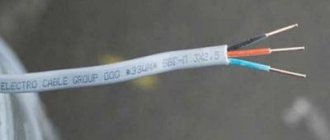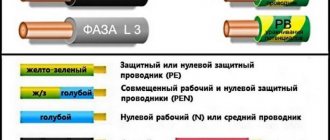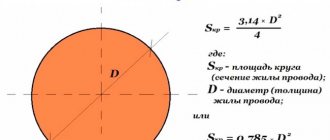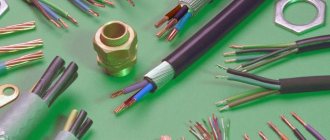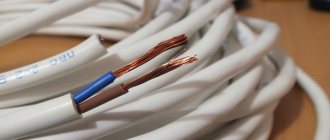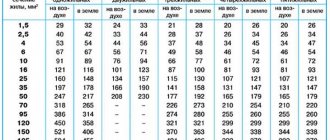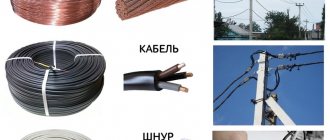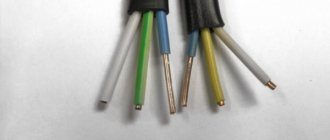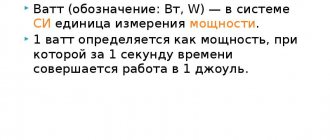When installing electrical wiring in an apartment or private house, it is very important to choose the correct wire cross-section. If you take a cable that is too thick, it will cost you a pretty penny, since its price directly depends on the diameter (section) of the conductors. The use of a thin cable leads to its overheating and if the protection does not work, the insulation may melt, a short circuit and, as a result, a fire. The most correct choice would be the wire cross-section depending on the load, which is reflected in the tables below.
Cable cross-section
The cable cross-section is the cut area of the current-carrying core. If the cut of the core is round (as in most cases) and consists of one wire, then the area/section is determined by the formula for the area of a circle. If there are many wires in the core, then the cross-section will be the sum of the cross-sections of all the wires in this core.
The cross-sectional values are standardized in all countries, and the standards of the former CIS and Europe in this part completely coincide. In our country, the document that regulates this issue is the “Rules for the Construction of Electrical Installations” or briefly - PUE.
The cable cross-section is selected based on the loads using special tables called “Permissible current loads on the cable.” If you have no desire to understand these tables, then it is enough for you to know that it is advisable to use a copper cable with a cross-section of 1.5-2.5 mm² for sockets, and 1.0-1.5 mm² for lighting.
To introduce one phase into an ordinary 2-3 room apartment, 6.0 mm² is quite enough. All the same, your 40-80 m² will not fit larger equipment, even taking into account the electric stove.
Many electricians, in order to “estimate” the required cross-section, believe that 1mm² of copper wire can pass 10A of electric current through itself: accordingly, 2.5 mm² of copper can pass 25A, and 4.0 mm² - 40A, etc. If you analyze the cable cross-section selection table a little, you will see that this method is only suitable for estimation and only for cables with a cross-section no higher than 6.0 mm².
Below is an abbreviated table for selecting cable cross-sections up to 35 mm² depending on current loads. For your convenience, the total power of electrical equipment is given there for 1-phase (220V) and 3-phase (380V) consumption.
When laying the cable in a pipe (i.e. in any closed spaces), the possible current loads on the cable should be less than when laying it openly. This is due to the fact that the cable heats up during operation, and heat transfer in a wall or in the ground is much lower than in open space.
When the load is called in kW, we are talking about the total load. Those. for a single-phase consumer, the load will be indicated for one phase, and for a three-phase consumer - in total for all three. When the load value is named in amperes (A), we are always talking about the load on one core (or phase).
Load table for cable cross-section:
| Cable cross-section, mm² | Laid open | Installed in a pipe | ||||||||||
| copper | aluminum | copper | aluminum | |||||||||
| current, A | power, kWt | current, A | power, kWt | current, A | power, kWt | current, A | power, kWt | |||||
| 220V | 380V | 220V | 380V | 220V | 380V | 220V | 380V | |||||
| 0.5 | 11 | 2.4 | ||||||||||
| 0.75 | 15 | 3.3 | ||||||||||
| 1 | 17 | 3.7 | 6.4 | 14 | 3 | 5.3 | ||||||
| 1.5 | 23 | 5 | 8.7 | 15 | 3.3 | 5.7 | ||||||
| 2.5 | 30 | 6.6 | 11 | 24 | 5.2 | 9.1 | 21 | 4.6 | 7.9 | 16 | 3.5 | 6 |
| 4 | 41 | 9 | 15 | 32 | 7 | 12 | 27 | 5.9 | 10 | 21 | 4.6 | 7.9 |
| 6 | 50 | 11 | 19 | 39 | 8.5 | 14 | 34 | 7.4 | 12 | 26 | 5.7 | 9.8 |
| 10 | 80 | 17 | 30 | 60 | 13 | 22 | 50 | 11 | 19 | 38 | 8.3 | 14 |
| 16 | 100 | 22 | 38 | 75 | 16 | 28 | 80 | 17 | 30 | 55 | 12 | 20 |
| 25 | 140 | 30 | 53 | 105 | 23 | 39 | 100 | 22 | 38 | 65 | 14 | 24 |
| 35 | 170 | 37 | 64 | 130 | 28 | 49 | 135 | 29 | 51 | 75 | 16 | 28 |
To independently calculate the required cable cross-section, for example, for entry into a house, you can use a cable calculator or select the required cross-section from the table.
This table applies to cables and wires with rubber and plastic insulation. These are such widespread brands as: PVS, GDP, VPP, PPV, APPV, VVG. AVVG and a number of others. Paper-insulated cables have their own table, and non-insulated wires and buses have their own.
When calculating the cable cross-section, the specialist must also take into account the methods of laying the cable: in trays, in bundles, etc.
- In addition, the values from the tables on permissible current loads must be adjusted by the following reduction factors:
- correction factor corresponding to the cable cross-section and its location in the block;
- correction factor for ambient temperature;
- correction factor for cables laid in the ground;
- correction factor for different numbers of operating cables laid nearby.
What to do with the length
If you are counting cables in an apartment or small house, then you don’t have to make any adjustments to the cable length at all - it’s unlikely that you will have branches 100 meters or more in length. But if you are laying wiring in a large multi-story cottage or shopping center, then you must take into account possible losses along the length. Usually they are 5 percent, but it is more correct to calculate them using a table and formulas.
So, the load moment is calculated as the product of the length of your wire and the total power consumption. That is, the length of your cable is calculated as the product of the cable length in meters and the power in kilowatts.
In the table below we see how losses depend on the cross-section of the conductor. For example, a cable with a thickness of 2.5 mm2 with a load of up to 3 kW and a length of 30 meters has a loss of 30x3 = 90, that is, 3%. If the loss level exceeds 5%, then it is recommended to choose a thicker cable - there is no need to skimp on your safety.
| U, % | Load moment, kW*m | |||||
| 1,5 | 2,5 | 4 | 6 | 10 | 16 | |
| 1 | 18 | 30 | 48 | 72 | 120 | 192 |
| 2 | 36 | 60 | 96 | 144 | 240 | 384 |
| 3 | 54 | 90 | 144 | 216 | 360 | 575 |
| 4 | 72 | 120 | 192 | 288 | 480 | 768 |
| 5 | 90 | 150 | 240 | 360 | 600 | 960 |
This table of loads by cable cross-section is valid for a single-phase network. Three-phase is characterized by an average increase in load size of six times. The value increases three times due to distribution over three phases, and two times due to the neutral conductor. If the load on the phases is uneven (there are strong distortions), then losses and loads increase greatly.
Correct connection of machines with copper cable
You should also consider which consumers will be connected to your wire. If you plan to connect halogen low-voltage lamps, then try to place them as close to the transformers as possible. Why? Because if the voltage drops by 3 volts at 220 volts, we simply won’t notice, and if the voltage drops by the same 3 volts at 12 volts, the lamps simply won’t light up.
If you select the wire cross-section according to the current for an aluminum cable, then keep in mind that the resistance of the material is 1.7 times higher than that of copper. Accordingly, losses in them will be greater by the same 1.7 times.
Calculation of wire cross-section
Let's start not with a table, but with a calculation. That is, each person, without having the Internet at hand, where the PUE with tables is freely available, can independently determine the cable cross-section by current. To do this you will need a caliper and a formula.
If we consider the cross-section of the cable, it is a circle with a certain diameter. There is a formula for the area of a circle: S = 3.14*D²/4, where 3.14 is the Archimedean number, “D” is the diameter of the measured core. The formula can be simplified: S=0.785*D².
If the wire consists of several cores, then the diameter of each is measured, the area is calculated, then all the indicators are summed up. How to calculate the cross-section of a cable if each core consists of several thin wires?
The process becomes a little more complicated, but not much. To do this, you will have to count the number of wires in one core, measure the diameter of one wire, calculate its area using the described formula and multiply this figure by the number of wires. This will be the cross section of one core. Now you need to multiply this value by the number of cores.
If you don’t want to count the wires and measure their sizes, you just need to measure the diameter of one core, consisting of several wires. You must take measurements carefully so as not to crush the core. Please note that this diameter is not exact because there is space between the wires.
Relation between current and cross section
To understand how an electrical cable works, you need to remember a regular water pipe. The larger its diameter, the more water will pass through it. It's the same with wires.
The larger their area, the greater the current that will pass through them, the greater the load such a wire can withstand. In this case, the cable will not overheat, which is the most important requirement of fire safety rules.
Therefore, the cross-section - current connection is the main criterion that is used in the selection of electrical wires in the wiring. Therefore, you need to first figure out how many household appliances and what total power will be connected to each loop.
| Wire core cross-section, mm2 | Copper conductors | Aluminum conductors | ||
| Current, A | Power, W | Current, A | Power, W | |
| 0.5 | 6 | 1300 | ||
| 0.75 | 10 | 2200 | ||
| 1 | 14 | 3100 | ||
| 1.5 | 15 | 3300 | 10 | 2200 |
| 2 | 19 | 4200 | 14 | 3100 |
| 2.5 | 21 | 4600 | 16 | 3500 |
| 4 | 27 | 5900 | 21 | 4600 |
| 6 | 34 | 7500 | 26 | 5700 |
| 10 | 50 | 11000 | 38 | 8400 |
| 16 | 80 | 17600 | 55 | 12100 |
| 25 | 100 | 22000 | 65 | 14300 |
For example, the kitchen must have a refrigerator, microwave, coffee grinder and coffee maker, an electric kettle and sometimes a dishwasher. That is, all these devices can be turned on simultaneously at the same time. Therefore, the total power of the room is used in the calculations.
You can find out the power consumption of each device from the product passport or on the tag.
- For example, let's designate some of them:
- Kettle – 1-2 kW.
- Microwave and meat grinder 1.5-2.2 kW.
- Coffee grinder and coffee maker – 0.5-1.5 kW.
- Refrigerator 0.8 kW.
Having found out the power that will act on the wiring, you can select its cross-section from the table. We will not consider all the indicators in this table; we will show those that prevail in everyday life.
What is the difference between a cable and a wire?
Before moving on to the main content, we need to understand what we still want to calculate, the cross-section of a wire or cable, what are the differences between one and the other!? Despite the fact that the average person uses these two words as synonyms, meaning by this something of their own, but if we are meticulous, there is still a difference.
So a wire is one conductive core, be it a single core or a set of conductors, insulated into a dielectric, into a sheath. But a cable is already several such wires combined into a single whole, in its own protective and insulating sheath. In order for you to better understand what's what, take a look at the picture.
So, now we know that we need to calculate exactly the cross-section of the wire, that is, one conductive element, and the second will already move away from the load, back to the power supply.
However, sometimes we ourselves forget ourselves no better than you, so if you catch us by the fact that somewhere you still come across the word cable, then do not consider it ignorance, stereotypes do their job.
Cable selection
It is best to make internal wiring using copper wires. Although aluminum ones are not inferior to them. But there is one nuance here, which is associated with the correct connection of sections in the distribution box. As practice shows, connections often fail due to oxidation of the aluminum wire.
Another question is which wire to choose: single-core or stranded? Single-core has better current conductivity, so it is recommended for use in household electrical wiring. Multicore has high flexibility, which allows it to be bent in one place several times without compromising quality.
Single or stranded
When installing electrical wiring, wires and cables of the PVS, VVGng, PPV, APPV brands are usually used. This list contains both flexible cables and monocore cables.
Here we would like to tell you one thing. If your wiring will not move, that is, it is not an extension cord, or a bend point that constantly changes its position, then it is preferable to use a monocore.
You will ask why? It's simple! No matter how well the conductors are laid in the protective insulating braid, air containing oxygen will still get under it. Oxidation of the copper surface occurs.
As a result, if there are many conductors, then the oxidation area is much larger, which means the current-carrying cross-section “melts” much more. Yes, this is a long process, but we don’t think that you are going to change the wiring often. The more she works, the better.
This oxidation effect will be especially pronounced at the edges of the cable cut, in rooms with temperature changes and high humidity. So we strongly recommend that you use monocore! The cross-section of a monocore cable or wire will change slightly over time, and this is so important for our further calculations.
Copper or aluminum
In the USSR, most residential buildings were equipped with aluminum wiring; this was a kind of norm, standard, and even dogma. No, this does not mean at all that the country was poor and there was a shortage of copper. Even in some cases it's the other way around.
But apparently the designers of electrical networks decided that they could save a lot economically if they used aluminum rather than copper. Indeed, the pace of construction was enormous; just remember the Khrushchev buildings, in which half of the country still lives, which means the effect of such savings was significant. There is no doubt about this.
However, today the realities are different, and aluminum wiring is not used in new residential premises, only copper. This is based on the rules of the PUE, clause 7.1.34 “Cables and wires with copper conductors should be used in buildings...”.
So, we strongly do not recommend that you experiment and try aluminum. Its disadvantages are obvious. Aluminum strands cannot be soldered and are also very difficult to weld; as a result, the contacts in the junction boxes may break over time. Aluminum is very fragile, two or three bends and the wire falls off.
There will be constant problems connecting it to sockets and switches. Again, if we talk about conducted power, then a copper wire with the same cross-section for aluminum is 2.5 mm2. allows a continuous current of 19A, and for copper 25A. Here the difference is more than 1 kW.
So let’s repeat it again - only copper! Further, we will proceed from the fact that we are calculating the cross-section for a copper wire, but in the tables we will also give values for aluminum. You never know.
Why is the calculation made?
Wires and cables that carry electrical current are the most important part of electrical wiring.
The wire cross-section must be calculated to ensure that the selected wire meets all the requirements for reliability and safe operation of electrical wiring.
Safe operation is that if you choose a cross-section that does not correspond to its current loads, this will lead to excessive overheating of the wire, melting of the insulation, short circuit and fire.
Therefore, the issue of choosing a wire cross-section must be taken very seriously.
What you need to know
The main indicator by which a wire is calculated is its long-term permissible current load. Simply put, this is the amount of current that it is capable of passing for a long time.
To find the rated current value, you need to calculate the power of all connected electrical appliances in the house. Let's consider an example of calculating the wire cross-section for an ordinary two-room apartment.
Table of power/current consumption of household electrical appliances
| electrical appliance | Power consumption, W | Current strength, A |
| Washing machine | 2000 – 2500 | 9,0 – 11,4 |
| Jacuzzi | 2000 – 2500 | 9,0 – 11,4 |
| Electric floor heating | 800 – 1400 | 3,6 – 6,4 |
| Stationary electric stove | 4500 – 8500 | 20,5 – 38,6 |
| microwave | 900 – 1300 | 4,1 – 5,9 |
| Dishwasher | 2000 – 2500 | 9,0 – 11,4 |
| Freezers, refrigerators | 140 – 300 | 0,6 – 1,4 |
| Electric meat grinder | 1100 – 1200 | 5,0 – 5,5 |
| Electric kettle | 1850 – 2000 | 8,4 – 9,0 |
| Electric coffee maker | 630 – 1200 | 3,0 – 5,5 |
| Juicer | 240 – 360 | 1,1 – 1,6 |
| Toaster | 640 – 1100 | 2,9 – 5,0 |
| Mixer | 250 – 400 | 1,1 – 1,8 |
| Hairdryer | 400 – 1600 | 1,8 – 7,3 |
| Iron | 900 –1700 | 4,1 – 7,7 |
| Vacuum cleaner | 680 – 1400 | 3,1 – 6,4 |
| Fan | 250 – 400 | 1,0 – 1,8 |
| TV | 125 – 180 | 0,6 – 0,8 |
| Radio equipment | 70 – 100 | 0,3 – 0,5 |
| Lighting devices | 20 – 100 | 0,1 – 0,4 |
Once the power is known, the calculation of the cross-section of a wire or cable comes down to determining the current strength based on this power. You can find the current strength using the formula:
1) Formula for calculating current for a single-phase 220 V network:
current calculation for a single-phase network
where P is the total power of all electrical appliances, W; U—mains voltage, V; CI = 0.75 - simultaneity coefficient; cos for household electrical appliances - for household electrical appliances. 2) Formula for calculating the current in a three-phase 380 V network:
current calculation for a three-phase network
Knowing the magnitude of the current, the wire cross-section is found from the table. If it turns out that the calculated and tabulated current values do not coincide, then in this case the nearest larger value is selected. For example, the calculated current value is 23 A, we select the nearest larger one from the table, 27 A - with a cross-section of 2.5 mm2.
Which wire is better to use
Today, for installation of both open and hidden electrical wiring, copper wires are, of course, very popular.
- Copper, compared to aluminum, is more effective:
- it is stronger, softer and does not break in places of inflection compared to aluminum;
- less susceptible to corrosion and oxidation. When connecting aluminum in a junction box, the twist points oxidize over time, which leads to loss of contact;
- The conductivity of copper is higher than that of aluminum; with the same cross-section, a copper wire can withstand a higher current load than aluminum.
The disadvantage of copper wires is their high cost. Their cost is 3-4 times higher than aluminum ones. Although copper wires are more expensive, they are still more common and popular in use than aluminum wires.
Selection of conductor cross-section by power
When choosing a cable cross-section based on power, it is necessary to calculate its total value. To do this, a list of all electrical appliances at the site is compiled. Both on the devices and in the technical documentation for them, the power consumption is indicated. It can be indicated in watts and kilowatts. By adding up the indicators of all devices we get the final sum.
If wiring is selected for a separate line to which one device will be connected, then information is taken only about its energy consumption. For example, the average iron consumes one kilowatt. The cross section itself can be selected using the PUE. Below are two tables for copper and aluminum conductors respectively.
Wire cross-section and power Source m-strana.ru
Table of cable cross-section by power and current for aluminum conductors Source m-strana.ru
In addition to the data given in the tables, it is necessary to take into account the type of network - one phase or three. The voltage of one phase directly depends on this - it is 220 volts, and three 380 volts. We have provided tables for copper and aluminum conductors. Copper is the preferred material because it:
- has high electrical conductivity;
- durable;
- resistant to oxidation;
- elastic.
While superior to aluminum conductors in many respects, copper conductors have only one drawback - high cost. In Soviet-built houses, as a rule, aluminum wires are laid. Therefore, when repairing, it is advisable to use the same ones.
An exception may be a major overhaul with a complete replacement of communications to the distribution board. In this case, it is better to use copper conductors. Direct contact between the two types of wiring is not permitted. This leads to oxidation, heating and short circuits. For connection, special conductors made of third metal are used.
Calculation of the cross-section of copper wires and cables
Having calculated the load and decided on the material (copper), let’s consider an example of calculating the cross-section of wires for individual groups of consumers, using the example of a two-room apartment.
As you know, the entire load is divided into two groups: power and lighting.
In our case, the main power load will be the socket group installed in the kitchen and bathroom. Since the most powerful equipment is installed there (electric kettle, microwave, refrigerator, boiler, washing machine, etc.).
For this socket group we select a wire with a cross section of 2.5mm2. Provided that the power load will be scattered across different outlets. What does it mean? For example, in the kitchen, to connect all household appliances, you need 3-4 sockets connected with copper wire with a cross-section of 2.5 mm2 each.
If all equipment is connected through one single socket, then a cross-section of 2.5 mm2 will not be enough, in this case you need to use a wire with a cross-section of 4-6 mm2. In living rooms, a wire with a cross section of 1.5 mm2 can be used to power sockets, but the final choice must be made after appropriate calculations.
The entire lighting load is powered by a wire with a cross section of 1.5 mm2.
It is necessary to understand that the power in different sections of the electrical wiring will be different, and accordingly the cross-section of the supply wires will also be different. Its greatest value will be in the introductory section of the apartment, since the entire load passes through it. The cross-section of the input supply wire is selected 4 - 6 mm2.
When installing electrical wiring, wires and cables of the PVS, VVGng, PPV, APPV brands are used.
Selection of cable cross-section by power
Now we get to the essence of our article. However, everything that was above cannot be missed, which means we could not remain silent.
If we try to present the idea logically and simply, then a current of a certain strength can pass through each conventional cross-section of a conductor. This conclusion is quite logical and now all that remains is to find out these ratios and correlate them for different wire diameters, based on its type series.
It also cannot be ignored that here, when calculating the current cross section, temperature also comes into play. Yes, this is a new component – temperature. It is she who can influence the cross section. How and why, let's figure it out.
We all know about Brownian motion. On the constant displacement of ions in a crystal lattice. All this happens in all materials, including conductors. The higher the temperature, the greater these vibrations of ions within the material will be. And we know that current is the directed movement of particles.
So, the directed movement of particles will collide with ions in the crystal lattice, which will lead to an increase in resistance to current.
The higher the temperature, the higher the electrical resistance of the conductor. Therefore, by default, the wire cross-section for a certain current is taken at room temperature, that is, at 18 degrees Celsius. It is at this temperature that all reference values are given in the tables, including ours.
Despite the fact that we do not consider aluminum wires as wires for electrical wiring, at least in an apartment, they are nevertheless used in many places. Let's say for wiring on the street. That is why we will also present the values of the cross-section and current dependencies for aluminum wires.
So, for copper and aluminum there will be the following indicators of the dependence of the cross-section of the wire (cable) on the current (power). See table.
Table of conductors for maximum permissible current for their use in wiring:
Since 2001, aluminum wires have not been used for wiring in apartments. (PEU)
Yes, here, as our reader noted, we actually did not provide calculations, but only provided reference data, tabulated, based on these calculations. But we dare to tell you that for calculations it is necessary to go through many formulas and indicators. Starting from temperature, resistivity, current density and the like.
Therefore, we will leave such calculations for specialists. It should be noted that they are not final, since they may vary slightly depending on the standard for the material and the current reserve of the wire used in different countries.
But what we would also like to talk about is converting the wire cross-section to diameter. This is necessary when there is a wire, but for some reason there is no marking on it. In this case, the cross-section can be calculated from the diameter of the wire, and vice versa from the diameter of the cross-section.
Necessity of calculations
Modern electrical networks must meet the following requirements:
- operational safety;
- reliability of operation;
- economical consumption.
Calculation of the cable cross-section by power or other parameter is, first of all, necessary to comply with these requirements.
If the cross-sectional area of the wiring is insufficient, the load on it increases sharply and as a result leads to overheating. In turn, this is fraught with emergency situations that harm not only electrical equipment, but also the people using it.
The cable cross-section, which is higher than the nominal cross-section, allows for safe use of instruments and devices. However, this approach results in unjustified expenditure of funds on more expensive communications. Proper calculation of the cable cross-section allows you to maintain a balance between the safety and cost of power lines.
Let's give a small example. The task is to determine the wire cross-section for five kilowatts. To solve, you need to use the PUE tables. This is a regulatory reference document, the full name is “Rules for the construction of electrical installations”, it indicates 4 main criteria that determine the wiring cross-section:
- type of voltage - one or three phases;
- the material from which the conductor is made;
- conductor laying method;
- current in amperes or power in kilowatts.
This reference book contains the cable cross-section table we need. However, the value of five kilowatts is missing. In such cases, the next larger value is taken, in our case, five and a half kilowatts.
Modern wiring in apartments is made of copper and laid over the air. Based on these parameters, a conductor with a cross section of two and a half millimeters is suitable for solving the problem. In this case, the network should create no more than twenty-five amperes of current load.
Common cross-sections for wiring in an apartment
We talked a lot about names, materials, individual characteristics and even temperature, but we lost sight of life circumstances.
So, if you hire an electrician to conduct wiring in the rooms of your apartment or house, then the following values are usually accepted. For lighting, the wire cross-section is taken at 1.5 mm 2, and for sockets at 2.5 mm 2.
If the wiring is intended for connecting boilers, heaters, stoves, then the cross-section of the wire (cable) is already calculated individually.
Selecting the wire cross-section based on the number of consumers
What I also wanted to say is that it is better to use several independent power lines for each room in a room or apartment. Thus, you will not use a wire with a cross-section of 10 mm 2 for the entire apartment, routed to all rooms, from which there are taps.
Such a wire will come to the input machine, and then from it, in accordance with the power of the consumed load, selected wire sections will be routed for each of the rooms.
Typical electrical wiring diagram for an apartment or house with an electric stove (indicating the cable cross-section for electrical appliances)
Introduction
A cable is a wire covered with insulation that serves to transmit electricity from a source to a consumer. Today's market is ready to offer customers many types of similar wires: aluminum, copper, single-core, multi-core, single- and double-insulated, with a cross-section from 0.35 mm2 to 25 mm2 or more. But most often, to connect household consumers, cables with a thickness of 0.5 to 6 square meters are used - this is quite enough to power any equipment.
Classic cable for wiring in an apartment
Why is it necessary to select insulated conductors, and not buy the first one you come across? The thing is that the thickness of the conductor determines the current strength it can withstand. For example, the permissible current for copper wires 1 mm thick is up to 8 Amperes, aluminum – up to 6 Amps.
Why not just buy the thickest wire possible? Because the thicker it is, the more expensive it is. In addition, a thick cable needs to be hidden somewhere, a groove must be cut for it in the ceiling and walls, and holes must be made in the partitions. In a word, there is no point in overpaying, because you won’t be driving a KAMAZ to buy bread.
If you choose a wire with a smaller diameter, it simply cannot withstand the current passing through it and will begin to heat up. This leads to insulation melting, short circuit and fire. Therefore, you should never rush when choosing a high-quality cable for connecting any devices - first think about what exactly will work on the new line, and then choose the thickness and type of cable.
Current loads in DC networks
In networks with direct current, the cross section is calculated somewhat differently. The resistance of a conductor to direct voltage is much higher than to alternating current (with alternating current, resistance at lengths of up to 100 m is generally neglected).
In addition, for DC consumers, as a rule, it is very important that the voltage at the ends is not lower than 0.5V (for AC consumers, as is known, voltage fluctuations within 10% in any direction are acceptable).
There is a formula that determines how much the voltage at the ends will drop compared to the base voltage, depending on the length of the conductor, its resistivity and the current in the circuit:
U = ((pl)/S)I
- Where:
- U—DC voltage, V
- p—wire resistivity, Ohm*mm2/m
- l — wire length, m
- S - cross-sectional area, mm2
- I - current strength, A
Knowing the values of these indicators, it is quite easy to calculate the cross section you need: by substitution method, or using simple arithmetic operations on this equation.
If the DC voltage drop at the ends does not matter, then to select the cross-section you can use the table for alternating current, but at the same time adjust the current values by 15% towards a decrease, i.e. with direct current, reference cable cross-sections can carry 15% less current than indicated in the table.
A similar rule also works for selecting circuit breakers for networks with direct current, for example: for circuits with a load of 25A, you need to take a circuit breaker with a 15% lower rating; in our case, the previous standard size of the circuit breaker is suitable - 20A.
The cable that transmits electric current is one of the most important elements of the electrical network. If the cable fails, the operation of the entire system becomes impossible, therefore, to prevent failures, as well as the risk of fire from overheating, an accurate calculation of the cable cross-section for the load should be made.
This calculation gives confidence in the safe and reliable operation of the network and devices, but more importantly, the safety of people.
Choosing a cross-section that is insufficient for the current load leads to overheating, melting and damage to the insulation, and this, in turn, leads to a short circuit and even a fire. So there are many reasons to carry out calculations and carefully select the appropriate cable.
What is needed for load calculations
The main indicator that helps calculate the cross-section and brand of cable is the maximum permissible continuous load (current). To put it simply, this is the amount of current that the cable is capable of passing under the conditions of its installation without overheating for a sufficiently long time.
This requires a simple arithmetic summation of the powers of all electrical appliances that will be connected to the network.
The next important step to achieve safety is to calculate the cable cross-section for the load, for which it is necessary to calculate the current strength using the formula:
For a single-phase 220 V network:
- Where:
- P is the total power for all electrical appliances, W;
- U—mains voltage, V;
- COSφ - power factor.
For a three-phase network with a voltage of 380 V:
| Device name | Approximate power, W |
| LCD TV | 140-300 |
| Fridge | 300-800 |
| Vacuum cleaner | 800-2000 |
| Computer | 300-800 |
| Electric kettle | 1000-2000 |
| Air conditioner | 1000-3000 |
| Lighting | 300-1500 |
| Microwave | 1500-2200 |
Having received the exact current value, you should refer to tables that allow you to find a cable or wire of the required cross-section and material. But if the obtained current value does not exactly coincide with the table value, then you should not “save”, but rather choose the nearest, but larger value of the cable cross-section.
Example: with a network voltage of 220 V, the resulting current value was 22 amperes, the nearest larger value (27 A) is a copper wire or copper cable with a cross-section of 2.5 mm square. This means that the optimal choice would be just such a cable, and not with a cross-section of 1.5 mm square, which has a permissible continuous current of 19 A.
| Cross-section of current-carrying conductors, mm | Copper conductors of wires and cables | |||
| Voltage 220V | Voltage 380V | |||
| Current, A | power, kWt | Current, A | power, kWt | |
| 1,5 | 19 | 4,1 | 16 | 10,5 |
| 2,5 | 27 | 5,9 | 25 | 16,5 |
| 4 | 38 | 8,3 | 30 | 19,8 |
| 6 | 46 | 10,1 | 40 | 26,4 |
| 10 | 70 | 15,4 | 50 | 33 |
| 16 | 85 | 18,7 | 75 | 49,5 |
| 25 | 115 | 25,3 | 90 | 59,4 |
| 35 | 135 | 29,7 | 115 | 75,9 |
| 50 | 175 | 38,5 | 145 | 95,7 |
| 70 | 215 | 47,3 | 180 | 118,8 |
| 95 | 260 | 57,2 | 220 | 145,2 |
| 120 | 300 | 66 | 260 | 171,6 |
If you choose a cable with aluminum cores, then it is better to take a core cross-section of 4 mm square rather than 2.5.
| Cross-section of current-carrying conductors, mm | Aluminum conductors of wires and cables | |||
| Voltage 220V | Voltage 380V | |||
| Current, A | power, kWt | Current, A | power, kWt | |
| 2,5 | 20 | 4,4 | 19 | 12,5 |
| 4 | 28 | 6,1 | 23 | 15,1 |
| 6 | 36 | 7,9 | 30 | 19,8 |
| 10 | 50 | 11 | 39 | 25,7 |
| 16 | 60 | 13,2 | 55 | 36,3 |
| 25 | 85 | 18,7 | 70 | 46,2 |
| 35 | 100 | 22 | 85 | 56,1 |
| 50 | 135 | 29,7 | 110 | 72,6 |
| 70 | 165 | 36,3 | 140 | 92,4 |
| 95 | 200 | 44 | 170 | 112,2 |
| 120 | 230 | 50,6 | 200 | 132 |
Dependence of current, power and core cross-section
It is not enough to measure and calculate the cross-sectional area of the cable based on the diameter of the core. Before installing wiring or other types of electrical networks, it is also necessary to know the capacity of the cable products.
- When choosing a cable, you must be guided by several criteria:
- the strength of the electric current that the cable will pass;
- consumer power;
- current load exerted on the cable.
Power
The most important parameter during electrical installation work (in particular, cable laying) is throughput. The maximum power of electricity transmitted through it depends on the cross-section of the conductor. Therefore, it is extremely important to know the total power of the energy consumption sources that will be connected to the wire. Typically, manufacturers of household appliances, appliances and other electrical products indicate on the label and in the documentation accompanying them the maximum and average power consumption.
For example, a washing machine can consume electricity ranging from tens of W/h during rinsing mode to 2.7 kW/h when heating water.
Accordingly, a wire with a cross-section that is sufficient to transmit electricity of maximum power must be connected to it. If two or more consumers are connected to the cable, then the total power is determined by adding the limit values of each of them. The average power of all electrical appliances and lighting devices in an apartment rarely exceeds 7500 W for a single-phase network. Accordingly, the cable cross-sections in the electrical wiring must be selected to this value.
It is recommended to round the cross-section towards higher power due to a possible increase in power consumption in the future. Typically, the next largest cross-sectional area from the calculated value is taken. So, for a total power of 7.5 kW, it is necessary to use a copper cable with a core cross-section of 4 mm2, which is capable of transmitting about 8.3 kW. The cross-section of the conductor with an aluminum core in this case must be at least 6 mm2, passing a current power of 7.9 kW.
